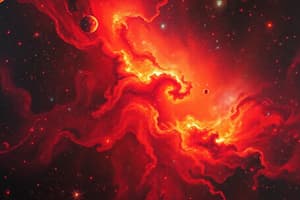Podcast
Questions and Answers
Which concept is associated with the idea that our universe is only one of many existing universes?
Which concept is associated with the idea that our universe is only one of many existing universes?
- Quantum Mechanics
- Oscillatory Universe Theory
- Multiverse Theory (correct)
- String Theory
What significant issue does the Inflationary Theory address in the standard Big Bang model?
What significant issue does the Inflationary Theory address in the standard Big Bang model?
- The formation of dark matter
- The creation of elementary particles
- The horizon and flatness problems (correct)
- The absence of gravitational waves
Which theory proposes a cyclical process of expansion and contraction of the universe?
Which theory proposes a cyclical process of expansion and contraction of the universe?
- Multiverse Theory
- Oscillatory Universe Theory (correct)
- Big Bang Theory
- Inflationary Theory
What common evidence supports both the Inflationary and Multiverse theories?
What common evidence supports both the Inflationary and Multiverse theories?
Which of the following statements is true regarding the Oscillatory Universe Theory?
Which of the following statements is true regarding the Oscillatory Universe Theory?
What percentage of the universe is composed of baryonic matter?
What percentage of the universe is composed of baryonic matter?
Which hypothesis suggests that the universe began from an extremely hot, dense point?
Which hypothesis suggests that the universe began from an extremely hot, dense point?
What is the approximate current estimated age of the universe?
What is the approximate current estimated age of the universe?
Which of the following elements is NOT one of the three most abundant in the universe?
Which of the following elements is NOT one of the three most abundant in the universe?
What is the role of gravity in the formation of stars within galaxies?
What is the role of gravity in the formation of stars within galaxies?
What does the term 'dark energy' refer to in the context of the universe's composition?
What does the term 'dark energy' refer to in the context of the universe's composition?
In which stage do hydrogen atoms fuse to form helium in stars?
In which stage do hydrogen atoms fuse to form helium in stars?
What provides evidence for an expanding universe?
What provides evidence for an expanding universe?
What significant event occurred about 380,000 years after the Big Bang?
What significant event occurred about 380,000 years after the Big Bang?
Which phenomenon describes the shift of light from distant objects towards the red end of the spectrum?
Which phenomenon describes the shift of light from distant objects towards the red end of the spectrum?
Who discovered the Cosmic Microwave Background Radiation and won the Nobel Prize for it?
Who discovered the Cosmic Microwave Background Radiation and won the Nobel Prize for it?
What does the Steady State Theory suggest about the universe?
What does the Steady State Theory suggest about the universe?
What most directly challenges the Steady State Theory?
What most directly challenges the Steady State Theory?
What are anisotropies in the context of the Cosmic Microwave Background Radiation?
What are anisotropies in the context of the Cosmic Microwave Background Radiation?
Who proposed the Steady State Theory in 1948?
Who proposed the Steady State Theory in 1948?
How did Edwin Hubble contribute to our understanding of the universe's expansion?
How did Edwin Hubble contribute to our understanding of the universe's expansion?
Flashcards are hidden until you start studying
Study Notes
Origin and Structure of the Planet Earth
- The universe comprises all matter and energy, including space and time.
- Composition: 4.6% baryonic matter, 24% cold dark matter, and 71.4% dark energy.
- Three most abundant elements: hydrogen, helium, and lithium.
- Stars form from clouds of gas and dust; gravitational collapse creates protostars.
- Galaxies consist of billions of stars; clusters of galaxies form superclusters.
- Universe age: 13.8 billion years, with a minimum diameter of 91 billion light-years.
- Density of the universe is approximately 4.5 x 10^-31 g/cm³.
- Stellar interiors synthesize elements through fusion; main sequence stars primarily fuse hydrogen into helium.
Theories of the Origin of the Universe
-
Big Bang Theory:
- Most widely accepted; suggests the universe began as a dense point and rapidly expanded.
- Formation of matter, space, and time occurred about 13.8 billion years ago.
- Evidence includes Cosmic Microwave Background Radiation (CMB), redshift of galaxies, and abundance of light elements.
-
Cosmic Microwave Background Radiation (CMB):
- Originated 380,000 years post-Big Bang during the recombination of protons and electrons into neutral hydrogen.
- Discovered accidentally in 1965 by Arno Penzias and Robert Wilson, leading to a Nobel Prize award.
- CMB shows uniformity with small fluctuations, which are vital for galaxy formation.
-
Redshift:
- Observed when light shifts towards the red spectrum, indicating objects are moving away.
- Edwin Hubble (1929) demonstrated this effect through spectral line observations.
-
Steady State Theory:
- Proposed in 1948; suggests the universe is eternal with continuous matter creation.
- Lost favor due to evidence supporting the Big Bang Theory, particularly with CMB discovery.
-
Inflationary Theory:
- Developed by Alan Guth (1981); posits an exponential expansion immediately following the Big Bang.
- Addresses issues in the standard Big Bang model, like horizon and flatness problems.
- Explains CMB uniformity and the universe’s large-scale structure.
-
Multiverse Theory:
- Suggests that our universe is just one of many, potentially with different physical laws.
- Linked to quantum mechanics and string theory contexts.
-
Oscillatory Universe Theory:
- Proposes cycles of expansion (Big Bang) and contraction (Big Crunch).
- Theoretical models in string theory hint at this cyclical nature, though lacking direct evidence.
Studying That Suits You
Use AI to generate personalized quizzes and flashcards to suit your learning preferences.




